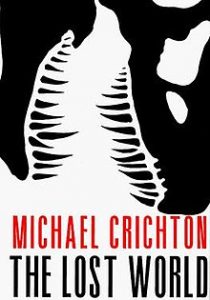In an interview on the “Jurassic Park Ultimate Trilogy” DVD set, Michael Crichton said “The Lost World” (1995) is “the only project I’ve ever worked on where I knew there would be a movie – there WOULD BE a movie.” But one could make a strong case that Crichton’s “Lost World” – despite Steven Spielberg’s 1997 movie bearing that title — still has not been adapted to the big screen.
A loose quality
This was partly by design. As Crichton added in the interview:
“When it became clear there was going to be a sequel (movie), I said ‘Steven, I’ll do a book and you do whatever you want in the movie.’ It had that kind of loose quality to me.”

“The Lost World” (1995)
Author: Michael Crichton
Series: “Jurassic Park” No. 2
Genre: Science fiction
Setting: Isla Sorna, off Pacific coast of Central America
Indeed, Spielberg and screenwriter David Koepp had different ideas for their version of “The Lost World,” as the only carryovers from book to film are:
- Site B (Isla Sorna), Jurassic Park’s factory island for making dinosaurs.
- Ian Malcolm and on-again, off-again girlfriend Sarah Harding, who studies animal behavior.
- A kid sneaks along on the mission.
- One major action sequence: The mom and dad T-rexes attack the trailer after Sarah sets the broken leg of the baby rex.
- A handful of small visual homages, such as a motorcycle being ridden under the body of an apatosaurus, someone observing a baby T-rex from high in a tree, raptors popping out of the long grass, pachycephalosaurs head-butting Jeeps, and the high hide.
In fact, enough of Crichton’s material was left over that “Jurassic Park III” (2001) used some of it, namely the concept of a rescue mission, and the raptor nest and egg theft.
Whereas the “Jurassic Park” movie is very faithful to the book, I can’t think of a movie that’s a less faithful adaptation than “The Lost World.” If you’ve only seen the movie, you don’t know the story from Crichton’s book.
Intellectual rivalry
Crichton not only borrows the title and the concept of a lost world from Arthur Conan Doyle’s classic 1912 novel, but he also creates a modern version of Professor Challenger, that classic headstrong, somewhat reckless archetype of old sci-fi adventure novels.
Feeling that the Costa Rican government will destroy Isla Sorna before too long, the brilliant but socially challenged Richard Levine heads off to the island to study dinosaurs in their (very loosely speaking) natural habitat.
Crichton ret-cons Malcolm back to life:
“It turned out I was only slightly dead. The surgeons have done wonders. … So now I’m back – in my next iteration, you might say.”
But rather than the voice of caution, as he was in the first novel/movie (and still is in the second movie), here he is the intellectual rival of Levine, as they seek evidence for their theories about dinosaur behavior and what led to their extinction.

In the first book, Malcolm sees chaos theory unfolding before his eyes and wants to escape; here, he wants to closely observe the dinosaurs and see how their behavior relates to his theories. When Sarah comes along, it’s actually to rescue Ian (a reverse of the movie), and she observes dinos as a bonus feature of the mission (whereas in the movie, she goes to the island specifically to observe the dinos).
With the shift in Malcolm’s character, the book’s voice of caution becomes Thorne, who designs the high-tech trailers, and we also see the scares and wonders of the island through Thorne’s young assistant, Eddie, and Levine’s teenage student stowaways, Arby and Kelly. (The names of Eddie and Kelly were used in the movie, but that’s about the extent of it.)
Biosyn’s Dodgson – joined by two henchmen — is a more active and ruthless villain this time around, as he attempts to steal dino eggs. When he gets fed to the baby rexes, it’s a delicious moment of comeuppance.
Peeks into dinosaur behavior
I remember reading Crichton’s book upon its release and envisioning everything in my mind’s eye; I felt like Crichton was intentionally writing movie scenes. For whatever reason, on this re-read I sympathized more with Koepp and Spielberg’s decision to go in a different direction, as Crichton’s “Lost World” is heavier on theme than plot.
Sure, it has the time-lock device of the group needing to meet the helicopter at a predesignated time and site. But the real reason it’s a page-turner is the series of revelations about dino behavior, including:
- T-rexes protect, teach and nourish their offspring, whereas with velociraptors – aside from the teamwork in the hunting process — it’s every raptor for itself. The book’s most shocking scene comes when Sarah observes raptors fighting each other over a kill. During the fight, one raptor gets wounded to the point where it becomes the next kill. This is the opposite of the raptors’ team-oriented behavior at the end of the first novel, when they aim to migrate to the mainland, and the “Raptor” comics.
- T-rexes’ vision is not motion-based after all. In retrospect, the reason our heroes didn’t all get eaten in “Jurassic Park” is that the rex simply wasn’t hungry, as it had just devoured a whole goat.
- Apatosaurs have long necks not to reach the tops of trees, but rather to serve as a suspension bridge for their long tails, which are defensive weapons.
- Parasaurolophusus and apatosaurs stick together in a strategy of mutual protection: The former has good eyesight, the latter has size.
- In a fun bit of speculation that can’t be backed up by the fossil record, but is representative of the surprises in store if dinos truly were cloned, carnotaurusus turn out have chameleon abilities. It’s similar to Crichton’s version of the acid-spitting dilophosaurus from “Jurassic Park.”
Dinosaur-human parallel
Although it doesn’t diminish the value of the discussion throughout “The Lost World,” Malcolm’s punchline about dinosaur extinction is a letdown, as he doesn’t come to a strong, evidence-backed conclusion. He intriguingly suggests that dinosaurs’ behavior was an agent in their extinction and that human behavior might be an agent in our extinction.
Crichton warns that the global village, of which the Internet is a major element, could create stagnation of ideas and innovation, and therefore lead to extinction. (Personally, I’d argue that a shift toward totalitarian governance in the U.S. – the world’s most powerful and influential country — poses a much bigger threat to innovation, but Crichton’s doesn’t go there.)
Crichton isn’t able to bridge the major difference between dinos and humans, though: Dinosaurs did not live in a global village. In fact, they didn’t even live on a single continent, as Pangaea had broken up into separate continents long before the dinosaurs’ extinction.
While it’s true that dinosaurs were connected worldwide in the sense that behavior of one dinosaur effects the behavior of another dinosaur, and so forth, that’s not stagnation; rather, it’s a catalyst for adaptation, which is a good thing in terms of avoiding extinction.
While Malcolm says the debate over whether an asteroid wiped out the dinosaurs is “a frivolous and irrelevant speculation,” he never makes a strong case for an alternate theory of dinosaurs’ worldwide extinction throughout the book’s 400-plus pages.
Furthermore, Malcolm argues that Isla Sorna’s velociraptors fail to nurture their young because they were all created in labs. So while they were armed with the genes of their ancestors (nature), they didn’t have the teaching of their parents (nurture), and therefore don’t know how to teach their own offspring. However, in the case of Isla Sorna’s T-rexes, genes appear to be enough, as they do teach, protect and nurture their offspring. Crichton never addresses this contradiction.
An isolated island
One surprise on this re-reading is that “The Lost World” has very little “dinosaurs on the mainland” material. Levine studies a big dinosaur carcass on the beach of Costa Rica before it is destroyed – like several carcasses before it – by the government. He presumes that this carcass washed ashore from an island.
(Incidentally, while “Jurassic Park” ends with all the characters essentially under house arrest in Costa Rica, they are going about their lives again in “The Lost World.” Presumably, the secrets of InGen and the Costa Rican government are protected by the simple fact that if Grant or Ellie or Malcolm shared their Isla Nublar experiences, no one would believe them. Also, InGen paid Malcolm’s medical bills, so perhaps he feels some loyalty. But it strikes me as odd that Malcolm bites his tongue about Jurassic Park even when hounded by people who WILL believe him, such as Sarah and Levine.)
However, all the material from “Jurassic Park” about compys and raptors in Central America is set aside in “The Lost World.” I have often thought that those mainland dinosaurs could’ve been the impetus for a third book.
Of course, we’ll never get a third book since Crichton died in 2008, but even if he were still alive, he might not have been inspired by another dinosaur-related big scientific idea the way he was with cloning (“Jurassic Park”) and extinction (“The Lost World”). However, it remains possible that future “Jurassic Park” movies will explore big ideas such as the weaponization of nature.
And while this summer’s “Jurassic World” is going back to the original theme park idea rather than the land-that-time-forgot idea of the “The Lost World” and “Jurassic Park III,” Crichton’s “Lost World” still has several action sequences – the raptors’ attack on the high hide is a pretty great one – that haven’t been adapted.
So maybe Crichton’s work will continue to inspire the movie franchise.

